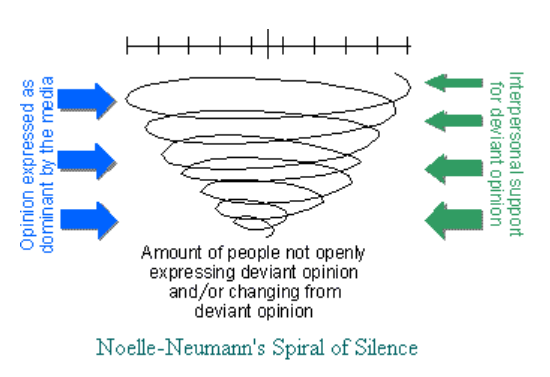On the last blog post, I have talked about the Cultivation Theory and how it has changed. Today, I will be talking about the Spiral of Silence model and its modifications due to digital media.
<What is Spiral of Silence?>
Spiral of Silence model explains that people (the public) stays silent due to the fear of isolation, if their opinion differs from the majority or the mass media. This model has three assumptions: one, the public has a ‘sixth-sense (quasi-statistical ability)’ which allows them to recognize the public opinion even without the access to the poll; two, people fear isolation by nature and always try to belong to majority (to be not included in the minority group); three, therefore, they do not express their opinion if it differs from the majority, in fear of isolation. The scholars exert that this is how the ‘dominant’ public opinion is formed.

This image visually represents the Spiral of Silence. It tries to show that people with similar opinion with the majority speaks out with confidence, whereas the minority opinion is held silent, which is represented by the downward spiral. As the majority speaks out more and more, the minority’s fear grows, making them even more silent because of the above-mentioned reasons. As a result, the major opinion dominates the public (the wider part of the spiral), and eventually the minor opinion is never voiced. What scholars are saying is that the media takes a major role in the Spiral of Silence. The media ‘dictates’ the major opinion through news, TV shows and more.
<Whathas changed?>
After digitalmedia and the internet has risen, a new model called ‘Spirals of SelectivityModel’ has came up to the surface. This model has its roots on how audiences nowhave the ability to select their media exposure to what they desire. Whenpeople do not agree or do not feel interested with a media content, they canselect other contents that can be identified with their own view. This leads toreinforcement effect, where it fosters people to believe in values and informationthat is outside of mainstream. As a result, there is a danger of attitude polarization,especially in the field of politics. However, with high number of choicesavailable these days, this model has little predictive power. Yet, it is worthwhileto study this field.
References:
www.utwente.nl/en/bms/communication-theories/sorted-by-cluster/Mass-Media/spiral_of_silence/
masscommtheory.com/theory-overviews/spiral-of-silence/



I hadn’t known these term ‘spiral of silence’-it’s an interesting metaphor to think of this phenomenon. I think we censor ourselves in lots of ways. For example, writing these blogs takes me much longer than writing for an essay with a small audience. I’m continually deleting, rewriting and asking myself what am I willing to share, will someone misunderstand me and the context I’m using, and what do I want to put out there as my opinion if I’m going to feel it needs clarification the next day, who’s judging me, did I misquote someone, did I acknowledge all my resources correctly, will people/authors be okay if I mention them as a resource, am I upsetting some niche group re: political correctness, that I might unwittingly upset, etc. It’s a lot of ways that put boundaries on personal expression.
I also found this an interesting link today about ‘psychological safety’ at work: http://www.bbc.com/capital/story/20181129-yes-you-should-really-be-yourself-at-work